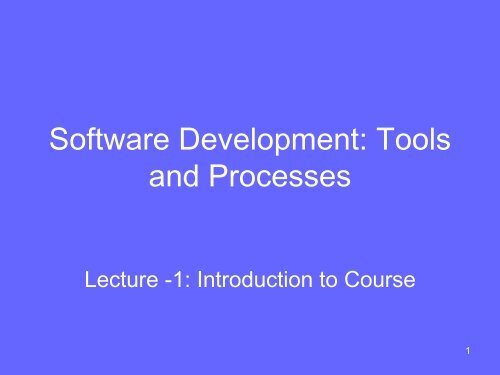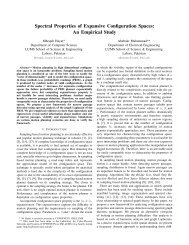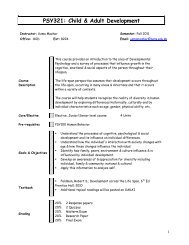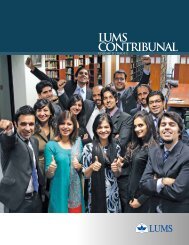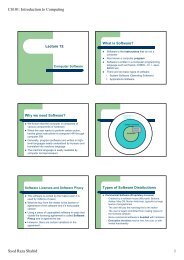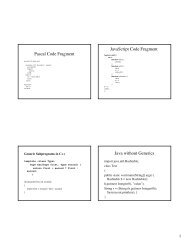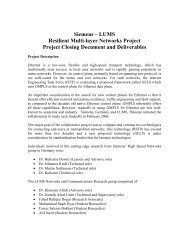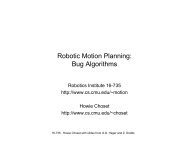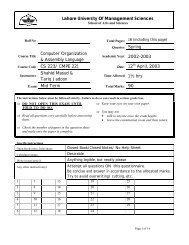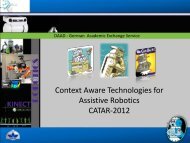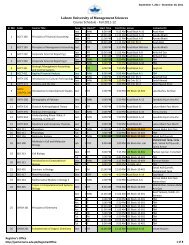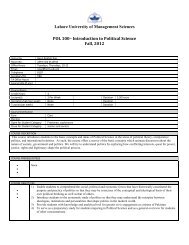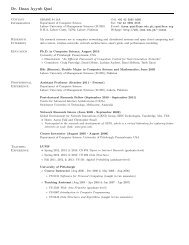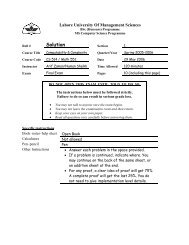Software Development: Tools and Process - Suraj @ LUMS
Software Development: Tools and Process - Suraj @ LUMS
Software Development: Tools and Process - Suraj @ LUMS
Create successful ePaper yourself
Turn your PDF publications into a flip-book with our unique Google optimized e-Paper software.
<strong>Software</strong> <strong>Development</strong>: <strong>Tools</strong><br />
<strong>and</strong> <strong>Process</strong>es<br />
Lecture -1: Introduction to Course<br />
1
Your Expectation <strong>and</strong> perception about<br />
the Course <br />
2
Course Outline discussion<br />
3
Module 1: Introduction<br />
• Introduction to course<br />
• <strong>Software</strong> development life cycle – overview of<br />
software development process models.<br />
• Review of software engineering concepts<br />
• 2 session of 75 minutes<br />
• Pressman, McConnel Chapter 6,8<br />
• Pankaj-1 Chapter 1,2<br />
4
Module 2: Introduction to CMMI<br />
• Key concepts of processes<br />
• Introduction to quality st<strong>and</strong>ards – CMMI –<br />
• Underst<strong>and</strong>ing the Architecture of CMMI –<br />
• Continuous <strong>and</strong> Staged Representations<br />
• Interpreting the CMMI<br />
• Attributes of level 1 organizations<br />
• 3 sessions 75 minutes each<br />
• Dennis Chapter 3 – 6, 9<br />
• Beth Chapter 1 - 5<br />
• McConnel Chapter 7<br />
5
Module 3: Detailed study of CMM<br />
• CMM appraisals - SCAMPI<br />
• <strong>Process</strong> Areas Discussion<br />
• Technology evolution & change<br />
management<br />
• 2 sessions 75 minutes each<br />
• www.sei.cmu.edu/cmmi<br />
• McConnel Chapter 14<br />
6
Module 4: Personal software process<br />
• Detailed discussion of personal software<br />
process <strong>and</strong> its application<br />
• 2 sessions 75 minutes each<br />
• Humphrey-1 Chapter 11 to 19<br />
• Mid Term Exam<br />
7
Module 5: Key concepts for software development processes<br />
• <strong>Software</strong> configuration management – example of SCM<br />
tool<br />
• <strong>Software</strong> quality assurance – example of quality<br />
assurance tool – QA activities<br />
• <strong>Software</strong> Estimation – function points <strong>and</strong> other methods<br />
• Requirement Elicitation <strong>and</strong> management<br />
• Case Study: Rapid development of a software project –<br />
mapping of artifacts<br />
• 5 sessions 75 minutes each<br />
• Pressman Chapter 9<br />
• Pankaj-2 Ch. 2, 6<br />
8
Module 6: Managing <strong>Software</strong> Projects<br />
• Problems in managing software projects –<br />
defining scope, extracting requirement,<br />
requirement creep, people factor -<br />
• Key success factors in management of<br />
Information system projects – Major<br />
causes of project failures<br />
• 2 sessions 75 minutes each<br />
• Flowers Chapter 7<br />
9
Module 7: Guest Speaker<br />
• <strong>Software</strong> development practices in<br />
industry<br />
• 1 sessions 75 minutes<br />
10
Module 8: Project Presentations<br />
• Presentation regarding projects by all<br />
groups<br />
• 2 session of 75 minutes<br />
11
Course Project<br />
Students will be required to perform CMMI<br />
based assessment of software<br />
development processes, for a selected<br />
software company. Next, they will give<br />
recommendations for the improvement of<br />
software processes with respect to CMMI<br />
framework.<br />
12
Grading <strong>and</strong> Exams<br />
Quizzes 15%<br />
Project 25%<br />
Midterm 25%<br />
Final 35%<br />
13
Review of Basic Concepts<br />
14
Review of <strong>Software</strong> Engineering Concepts<br />
What is the Difference between Art <strong>and</strong> Science<br />
• Art: The integration <strong>and</strong> manifestation into a state of being which<br />
allows a free flowing creative process using personally unique<br />
techniques evolved from the technical processes of a discipline<br />
• Science: the process of gaining knowledge based on making<br />
repeated observations about nature in controlled conditions<br />
(experimentation) <strong>and</strong> attempting to explain what causes those<br />
observations (theorizing) through constructing hypotheses that can<br />
be tested experimentally<br />
What is the Difference between Science <strong>and</strong><br />
Engineering<br />
• Engineering: the practical application of science to commerce or<br />
industry<br />
• Is software Engineering same as computer science<br />
15
Review of <strong>Software</strong> Engineering Concepts<br />
• What is <strong>Software</strong> Engineering<br />
• <strong>Software</strong> project starts with an idea <strong>and</strong> ends with a<br />
working product Whatever is done from the start till the<br />
end is called software engineering<br />
• A systematic approach towards building a software<br />
solution is called software engineering<br />
• System Engineering<br />
• Integrating software solution into existing business –<br />
software, hardware, people, etc.<br />
• Identification of sub-systems<br />
16
Review of <strong>Software</strong> Engineering Concepts<br />
<strong>Software</strong> Engineering – another<br />
definition<br />
• Bringing together the disciplined approach of<br />
engineering <strong>and</strong> creativity of an Artist to build<br />
required software solutions.<br />
<strong>Software</strong> development life cycle –<br />
SDLC<br />
• System engineering – requirement analysis –<br />
design – implementation – testing – deployment<br />
- maintenance<br />
17
Review of <strong>Software</strong> Engineering Concepts<br />
What is the difference between<br />
requirement specifications <strong>and</strong><br />
functional specifications<br />
18
Review of <strong>Software</strong> Engineering Concepts<br />
<strong>Software</strong> <strong>Process</strong> Models:<br />
• Waterfall Model<br />
• Incremental <strong>Development</strong> Model<br />
• Prototyping Model<br />
Which Model will you prefer<br />
We should know that which Model should be<br />
applied under what circumstances<br />
19
Questions!<br />
20


